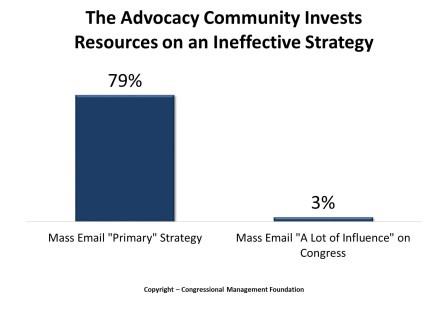By Seth Turner and Chip Felkel
Last week, The Congressional Management Foundation and the RAP Index joined forces on a webinar, Citizen Engagement: What Works and What Doesn't, which raised questions as to whether the most common grassroots advocacy tactic – identical mass email campaigns to Congress – actually are a good return on investment.
The State of Citizen Engagement

- Open rates
- Click rates
- The number of letters sent to Congress
Grassroots advocacy organizations commonly use these metrics because they can easily be reported using online grassroots advocacy platforms. However, organizations that are good at generating high open and click rates etc., should not assume that this success translates into influence on the policymakers they hope to influence.
If your goal is to clutter a bunch of legislative correspondents' and interns' inboxes, stop reading and keep doing what you are doing. If your goal is to influence decisions on the issues you care about, you need to do the following.
Embrace relationship building as a metric for success to augment other measurements.
Just like collecting data on the common metrics noted earlier, you need a system to collect, store, and make sense of information about your grassroots/grasstops advocates' activities and relationships. Examples of relationship-based metrics include the following.
- Number of supporters who are actively engaged with key lawmakers
- Frequency of in-person meetings and/or substantive communication between your supporters and their Members of Congress
- Lawmakers' visits to your supporters' facilities or events
- Number of advanced grassroots advocates represented by key lawmakers
Transition from quantitative grassroots metrics to qualitative.
CMF research finds that just 12 percent of congressional staff believe that the typical citizen advocate is well prepared for their meetings with Congress. A big reason for this low rating is because nonprofits, associations, and companies that invest thousands of dollars in the logistics of fly-ins make little or no investment in making their advocates successful. Your advocates spend DAYS traveling to and attending conferences and meetings in Washington related to advocacy, but too little of that time is spent on training advocates to have successful interactions and build relationships with lawmakers. (For more details on this, you can download this report from the CMF, "Citizen-Centric Advocacy: The Untapped Power of Constituent Engagement.")
A Winning Combination
Combined, using relationship-based metrics and training advocates is a winning combination. Advocacy organizations win because their supporters have the ability to form and sustain strong relationships with their lawmakers. Citizen advocates win because they build confidence and learn skills that can attract needed supports and resources. And Congress wins because it gets the information it needs from people who understand how important issues affect the people they represent.
Seth Turner is the Director of Citizen Engagement for the Congressional Management Foundation
Chip Felkel is the CEO & Founder of the RAP Index.


